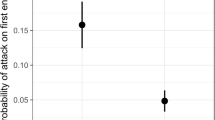Summary
Ants were collected with sets of pitfall traps in four coniferous-forest habitats in southern Finland. A three-level competition hierarchy concept was used to generate predictions on ant community structure. The levels of the hierarchy, and the respective predictions, from top to bottom were: (1) The dominant territorial wood ants (Formica rufa-group species), expected to exclude each other. (2) The other aggressive species, likely to be excluded by the F. rufa-group. (3) The submissive species, non-aggressive and defending only their nest, and thus likely to coexist with the dominants but in reduced numbers. As expected, the species of the F. rufa-group excluded each other, and the species number of the other aggressive ants was significantly cut down in the presence of the F. rufa-group. The aggressive species F. sanguinea and Camponotus herculeanus showed complementary occurrences with the F. rufa-group, and Lasius niger reduced occurrences. The number of the submissive species was not significantly affected by the F. rufa-group. However, pairwise correlation coefficients were significantly more often negative than positive between presence of the F. rufa-group and average proportion of pitfalls per set with a submissive species, each analyzed in turn. The result indicates that the F. rufa-group also reduced the colony densities of the submissive species. We conclude that in the taiga biome territorial wood ants are, after adjusting for physical vicissitudes of the environment, the major structuring force of ant species assemblages.
Similar content being viewed by others
References
Arnol'di KV (1937) Zhiznennye formy u murav'ev. Doklady Akademii Nauk SSSR 16:343–345
Arnol'di KV (1968) Zonal'nye zoogeograficheskie i ekologicheskie osobennosti mirmekofauny i naselenya murav'ev russkoj ravniny. Zool Zhurnal 47:1155–1178
Brian MV (1952) The structure of a dense natural ant population. J Anim Ecol 21:12–24
Brian MV (1955) Food collection by a Scottish ant community. J Anim Ecol 24:336–351
Brian MV (1956) Segregation of species of the ant genus Myrmica. J Anim Ecol 25:319–337
Cajander AK (1949) Forest types and their significance. Acta Forestalia Fennica 56:1–71
Carroll CR, Janzen DH (1973) Ecology of foraging by ants. Ann Rev Ecol Syst 4:231–257
Culver DC (1974) Species packing in Caribbean and north temperate ant communities. Ecology 55:974–988
Davidson DW (1977) Species diversity and community organization in desert seed-eating ants. Ecology 58:711–724
Dimitrienko VK, Petrenko ES (1976) Murav'i taezhnykh biotsenozov Sibiri. Nauka, Novosibirsk
Dlusskij GM (1967) Murav'i roda Formika. Nauka, Moscow
Dlusskij GM (1981) Murav'i pustyn'. Nauka, Moscow
Fellers JH (1987) Interference and exploitation in a guild of woodland ants. Ecology 68:1466–1478
Francoeur A, Pépin D (1978) Productivity of the ant Formica dakotensis in a spruce bog. 2. annual variations in colony density, nest inhabitation and spatial distribution. Ins Soc 25:13–30
Halme E (1987) The impact of forest fragmentation on the distribution of Carabid beetles (Coleoptera, Carabidae) in Espoo, M Sc thesis. University of Helsinki (in Finnish)
Hölldobler B, Wilson EO (1990) The ants. Harvard University Press, Cambridge, MA (in press)
Kaczmarek W (1953) Badania nad zespolami mrowek lesnych. Ekol Polska 1:69–86
Kutter H (1977) Hymenoptera Formicidae. Insecta Helvetica 6:1–298
Lynch JF (1981) Seasonal, successional, and vertical segregation in a Maryland ant community. Oikos 37:183–198
Lynch JF, Balinsky EC, Vail SG (1980) Foraging patterns in three sympatric forest ant species, Prenolepis imparis, Paratrechina melanderi and Aphaenogaster rudis (Hymenoptera: Formicidae)
Mabelis AA (1984) Interference between wood ants and other and species (Hymenoptera, Formicidae). Netherlands J Zool 34:1–20
Marikovskij PI (1962) O vnutrividovykh otnosheniyakh ryzhego lesnogo murav'ya Formica fufa L. (Hymenoptera, Formicidae). Entomol Obozr 41:83–93 (English translation in Ent Rev 41:47–51)
Pisarski B (1973) La structure sociale de la Formica (Coptoformica) exsecta Nyl. (Hymenoptera: Formicidae) et son influence sur la morphologie, l'écologie et l'éthologie de l'espece (in Polish with French summary). Institute of Zoology, Polish Academy of Sciences, Warsaw
Reznikova Zh I (1975) Neantagonisticheskie otnosheniya murav'ev, zanimayushchikh skhodnye ekologicheskie nishi. Zool Zhurnal 54:1020–1031
Reznikova Zh I (1976) Ierarkhia vidov v soobshchestve stepnykh murav'ev. In: Gruppovoe povedenie zhivotnykh. Nauka, Moscow, pp 315–318
Rice WR (1989) Analyzing tables of statistical tests. Evolution 43:223–225
Rosengren R, Vepsäläinen K, Wuorenrinne H (1979) Distribution, nest densities, and ecological significance of wood ants (the Formica rufa group) in Finland. Bull Srop 2–3:183–213
Savolainen R, Vepsäläinen K (1988) A competition hierarchy among boreal ants: impact on resource partitioning and community structure. Oikos 51:135–155
Savolainen R, Vepsäläinen K (1989) Niche differentiation of ant species within territories of the wood ant Formica polyctena. Oikos 56:3–16
Schoener TW (1986) Resource partitioning. In: Kikkawa J, Anderson DJ (eds) Community ecology. Pattern and Process. Blackwell, Oxford, pp 91–126
Stebaev I, Reznikova JI (1972) Two interaction types of ants living in steppe ecosystem in south Siberia, USSR. Ekol Polska 20:103–109
Stradling DJ (1987) Nutritional ecology of ants. In: Slansky F Jr, Rodriguez JG (eds) Nutritional ecology of insects, mites, spiders and related invertebrates. Wiley, New York, pp 927–969
Toft CA (1984) Resource shifts in bee flies (Bombyliidae): interactions among species determine choice of resources. Oikos 43:104–112
Vepsäläinen K, Pisarski B (1982) Assembly of island ant communities. Ann Zool Fennici 19:327–335
Vepsäläinen K, Wuorenrinne H (1978) Ecological effects of urbanisation on the mound-building Formica L. species. Memorabilia Zoologica (Warsaw) 29:191–202
Vepsäläinen K, Savolainen R, Penttinen A (1988) Causal reasoning in modelling multiway contingency tables. Oikos 53:281–285
Wilson EO (1971) The insect societies. The Belknap Press of the Harvard University Press, Cambridge, Mass
Wilson EO (1987) The arboreal ant fauna of Peruvian Amazon forests: a first assessment. Biotropica 2:245–251
Zakharov AA (1978) Muravej, sem'ya, koloniya. Nauka, Moscow
Author information
Authors and Affiliations
Rights and permissions
About this article
Cite this article
Savolainen, R., Vepsäläinen, K. & Wuorenrinne, H. Ant assemblages in the taiga biome: testing the role of territorial wood ants. Oecologia 81, 481–486 (1989). https://doi.org/10.1007/BF00378955
Received:
Accepted:
Issue Date:
DOI: https://doi.org/10.1007/BF00378955




